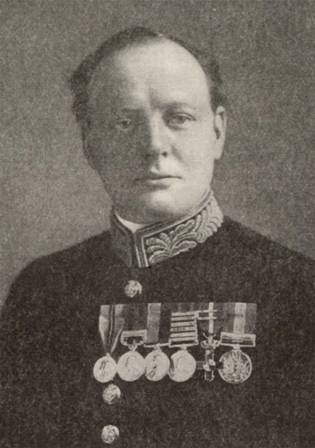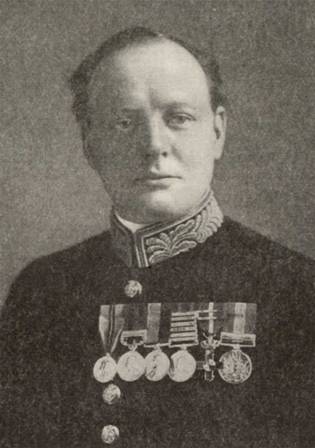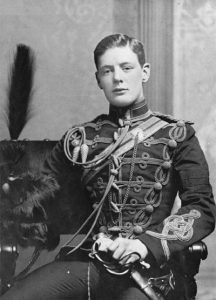
Young Soldier
Orders, Decorations and Medals

June 18, 2008
Excerpt from The Orders, Decorations and Medals of Sir Winston Churchill by Douglas S. Russell
As a young man, Winston Leonard Spencer Churchill set out to become a hero. In the event, he exceeded everyone’s expectations, save perhaps his own. Churchill was the recipient of a remarkable variety of honors and awards. Few statesmen have received so many honorary degrees, freedoms of cities, honorary citizenships and memberships. Few have been named honorary citizens of the United States. Although several received the Nobel Peace Prize, none save Churchill received the Nobel Prize for Literature.
Among Churchill’s honors are 37 orders, decorations and medals received between 1885 and 1963. Readers have surely noticed photographs of him at various stages of his career in military uniform or court dress wearing rows of colorful ribbon bars or a long row of medals. Reading and research over the past 12 years has brought to light much information and detail concerning these awards about which little was published before.
Of the orders, decorat ions and medals Churchill received, 20 were awarded by Great Britain, three by France, two each by Belgium, Denmark, Luxembourg and Spain, and one each by Egypt, Libya, Nepal, the Netherlands, Norway, and the United States. Ten were awarded for active service as an Army officer in Cuba, India, Egypt, South Africa, England, France, and Belgium. The greater number of awards were given in recognition of his service as a minister of the British government. All of the orders, medals and decorations awarded to Churchill have been located. Thirty-three are in the possession of his grandson, Winston S. Churchill, loaned for display at the Cabinet War Rooms, London. The other four were returned to the Sovereigns who granted them following Sir Winston’s death in 1965. All photographs are of Churchill’s actual awards, with the exception of the Order of the Garter insignia (collection of Spink & Son, Ltd., London) and the Danish and Netherlands orders, which are replicas on exhibit at the Dwight D. Eisenhower Library in Abilene, Kansas.
ions and medals Churchill received, 20 were awarded by Great Britain, three by France, two each by Belgium, Denmark, Luxembourg and Spain, and one each by Egypt, Libya, Nepal, the Netherlands, Norway, and the United States. Ten were awarded for active service as an Army officer in Cuba, India, Egypt, South Africa, England, France, and Belgium. The greater number of awards were given in recognition of his service as a minister of the British government. All of the orders, medals and decorations awarded to Churchill have been located. Thirty-three are in the possession of his grandson, Winston S. Churchill, loaned for display at the Cabinet War Rooms, London. The other four were returned to the Sovereigns who granted them following Sir Winston’s death in 1965. All photographs are of Churchill’s actual awards, with the exception of the Order of the Garter insignia (collection of Spink & Son, Ltd., London) and the Danish and Netherlands orders, which are replicas on exhibit at the Dwight D. Eisenhower Library in Abilene, Kansas.
 ions and medals Churchill received, 20 were awarded by Great Britain, three by France, two each by Belgium, Denmark, Luxembourg and Spain, and one each by Egypt, Libya, Nepal, the Netherlands, Norway, and the United States. Ten were awarded for active service as an Army officer in Cuba, India, Egypt, South Africa, England, France, and Belgium. The greater number of awards were given in recognition of his service as a minister of the British government. All of the orders, medals and decorations awarded to Churchill have been located. Thirty-three are in the possession of his grandson, Winston S. Churchill, loaned for display at the Cabinet War Rooms, London. The other four were returned to the Sovereigns who granted them following Sir Winston’s death in 1965. All photographs are of Churchill’s actual awards, with the exception of the Order of the Garter insignia (collection of Spink & Son, Ltd., London) and the Danish and Netherlands orders, which are replicas on exhibit at the Dwight D. Eisenhower Library in Abilene, Kansas.
ions and medals Churchill received, 20 were awarded by Great Britain, three by France, two each by Belgium, Denmark, Luxembourg and Spain, and one each by Egypt, Libya, Nepal, the Netherlands, Norway, and the United States. Ten were awarded for active service as an Army officer in Cuba, India, Egypt, South Africa, England, France, and Belgium. The greater number of awards were given in recognition of his service as a minister of the British government. All of the orders, medals and decorations awarded to Churchill have been located. Thirty-three are in the possession of his grandson, Winston S. Churchill, loaned for display at the Cabinet War Rooms, London. The other four were returned to the Sovereigns who granted them following Sir Winston’s death in 1965. All photographs are of Churchill’s actual awards, with the exception of the Order of the Garter insignia (collection of Spink & Son, Ltd., London) and the Danish and Netherlands orders, which are replicas on exhibit at the Dwight D. Eisenhower Library in Abilene, Kansas.In discussing Churchill’s orders, decorations and medals it is important and useful to define one’s terms. The awards discussed in this book are official ones given by national governments or heads of state for military or government services. They do not include diplomas, certificates, gifts, tokens or table medals from any source or medals from universities, local or state governments, or civil organizations public or private. Although the following definitions may not be universally accepted, they are used with consistency herein and will lend a clearer understanding and appreciation.
1. An Order is an institution, derived from the medieval monastic or secular orders of knighthood. Although originally closed fraternities, modern orders are honorific, having generally been created by a sovereign or head of state to reward meritorious service. An order is generally the highest honor a citizen may receive for a career or service of great distinction in the services of one’s country. Membership in an order is generally granted by the sovereign or head of state, who is typically the “grand master” of the order. In the UK the King or Queen is the “Sovereign” of each order and the “Great [or Grand] Master” is a member of the Royal Family. Membership is usually limited to a specific, small number. Orders may have several classes of membership which are denoted by a variety of insignia or badges of rank and distinction. The badges are often referred to as “orders.” The insignias typically are made of precious metals with enameled or jeweled designs.
2. A Decoration is an award conferred by a sovereign or national government for heroism, meritorious achievement or distinguished service. Decorations do not normally denote membership and are awarded for specific categories or types or service, civil or military, by an individual. Decorations usually take the form of crosses or medallions of gold, silver, bronze or enameled metal suspended from a ribbon and worn on the left side of the chest.
3. A Medal is an award given by a sovereign or national government to recognize the recipient’s participation in a military campaign, royal coronation or other significant event and is usually award to all who participated in the event. Medals are also given to recognize long periods of service in the military, in government, or in a royal household. Medals are usually medallion in form and are worn on the left side of the chest, suspended from a colorful ribbon.
I have written of Churchill’s orders, decorations and medals as a chronology, thinking it best to let the story be told as it happened. In some cases this means the sequence in which the awards were earned rather than the order in which they were received. The following order of precedence lists the awards in the official ranking and the order in which Churchill wore them. This book is a history of one aspect of Churchill’s career, one which I trust will be of interest both to those interested in orders, decorations and medals, and to those interested in Sir Winston Churchill.
The Order of Precedence
- Knight Companion of the Most Noble Order of the Garter, UK, appointed 24Apr53, installed 14Jun54.
- Order of Merit, UK, appointed 1Jan46, installed 8Jan46.
- Order of the Companions of Honour, UK, appointed 19Oct22, invested 16Jun23.
- India Medal, 1895 (clasp: Punjab Frontier 1897-98), UK, authorized 10Dec 1898.
- Queen’s Sudan Medal 1896-98, UK, authorized 27Mar 1899.
- Queen’s South Africa Medal 1899-1902 (clasps: Diamond Hill, Johannesburg, Relief of Ladysmith, Orange Free State, Tugela Heights, Cape Colony), UK, authorized 15Jul 1901.
- 1914-1915 Star, UK, authorized 10Oct19.
- British War Medal 1914-1918, UK, authorized 13Oct19.
- Victory Medal, UK, authorized 4Jun20.
- 1939-1945 Star, UK, authorized 9Oct45.
- Africa Star, UK, authorized 9Oct45.
- Italy Star, UK, authorized 2Aug45.
- France and Germany Star, UK, authorized 9Oct45.
- Defence Medal 1939-45, UK, authorized 9Oct45.
- War Medal 1939-45, UK, authorized 11Dec46.
- King George V Coronation Medal, UK, 1911.
- King George V Silver Jubilee Medal, UK, 1935.
- King George VI Coronation Medal, UK, 1937.
- Queen Elizabeth II Coronation Medal, UK, 1953.
- Territorial Decoration (King George V), UK, 31Oct24.
- Cross of the Order of Military Merit, Red Ribbon, First Class, Spain, granted 6Dec 1895, ratified 25Jan 1896.
- Grand Cordon of the Order of Leopold with Palm, Belgium, 15Nov45.
- Knight Grand Cross, Order of the Lion of the Netherlands, Holland, May 1946.
- Grand Cross, Order of the Oaken Crown, Luxembourg, 14Jul46.
- Grand Cross with Chain, Royal Norwegian Order of St. Olav, Norway, 11May48.
- Order of the Elephant, Denmark, 9Oct50.
- Order of Liberation, France, awarded 6Nov58.
- Most Refulgent Order of the Star of Nepal, First Class, Nepal, 29Jun61.
- Grand Sash of the High Order of Sayyid Mohammed bin Ali el Senoussi, Kingdom of Libya, awarded 14Apr62.
- Army Distinguished Service Medal, United States, authorized 10May19, awarded 16Jul19.
- War Cross with Palm, Belgium, 15Nov45.
- Military Medal 1940-45, Luxembourg, 14Jul46.
- Military Medal, France, 8May47.
- War Cross with palm, France, 8May47.
- Cuban Campaign Medal, 1895-98, Spain, awarded 1914.
- Khedive’s Sudan Medal (clasp: Khartoum), Egypt, 1899.
- King Christian X’s Liberty Medal, Denmark, 10Sep46.
Subscribe
WANT MORE?
Get the Churchill Bulletin delivered to your inbox once a month.




